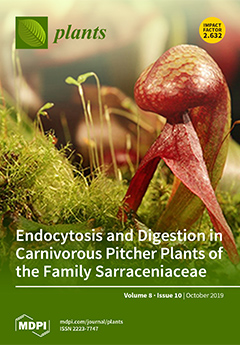Lycoris, which is known as the ‘Chinese tulip,’ has diverse flower colors and shapes, and some species have a delicate fragrance. However, limited studies have reported the volatile organic compounds (VOCs) of
Lycoris. In this study, headspace solid-phase microextraction combined with
[...] Read more.
Lycoris, which is known as the ‘Chinese tulip,’ has diverse flower colors and shapes, and some species have a delicate fragrance. However, limited studies have reported the volatile organic compounds (VOCs) of
Lycoris. In this study, headspace solid-phase microextraction combined with gas chromatography-mass spectrometry was used to analyze the floral VOCs of six typical
Lycoris taxa. Thirty-two VOCs were identified, including terpenoids, alcohols, esters, aldehydes, ketones, and phenols. The aldehyde and terpenoid contents in
Lycoris aurea were higher than in the other taxa, and the ester and alcohol contents in
L. sprengeri were the highest compared to all taxa tested. Compared with other species and cultivars,
L. longituba and
L. longituba var.
flava were the two most scented taxa and the VOCs were dominated by terpenoids and esters.
L. radiate and
L. chinensis were two unscented taxa and, accordingly, the VOC content was weak. A partial least squares discriminate analysis of the floral VOCs among the six
Lycoris taxa showed that the six taxa could be successfully separated. Moreover, the VOCs of
L. longituba and
L. longituba var.
flava clustered together. β-Ocimene was verified as the most important aroma compound, as determined via the calculation of the variable importance in projection values and significance analysis. β-Ocimene and its trans isomer,
trans-β-ocimene, had a high relative content in
L. longituba, L. longituba var.
flava, L. aurea, and
L. chinensis but were not detected in
L. sprengeri and
L. radiata. These results indicate that floral VOCs might be selected during the evolutional processes of
Lycoris, and β-ocimene could be the most typical VOC among the different
Lycoris taxa.
Full article






